初中英语说课优秀实用模板(全英)
- 格式:doc
- 大小:80.00 KB
- 文档页数:16
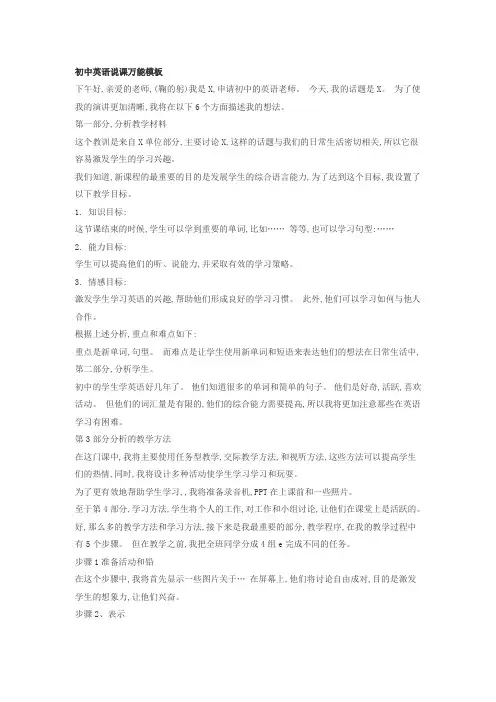
初中英语说课万能模板下午好,亲爱的老师,(鞠的躬)我是X,申请初中的英语老师。
今天,我的话题是X。
为了使我的演讲更加清晰,我将在以下6个方面描述我的想法。
第一部分,分析教学材料这个教训是来自X单位部分,主要讨论X,这样的话题与我们的日常生活密切相关,所以它很容易激发学生的学习兴趣。
我们知道,新课程的最重要的目的是发展学生的综合语言能力,为了达到这个目标,我设置了以下教学目标。
1. 知识目标:这节课结束的时候,学生可以学到重要的单词,比如……等等,也可以学习句型:……2. 能力目标:学生可以提高他们的听、说能力,并采取有效的学习策略。
3. 情感目标:激发学生学习英语的兴趣,帮助他们形成良好的学习习惯。
此外,他们可以学习如何与他人合作。
根据上述分析,重点和难点如下:重点是新单词,句型。
而难点是让学生使用新单词和短语来表达他们的想法在日常生活中, 第二部分,分析学生。
初中的学生学英语好几年了。
他们知道很多的单词和简单的句子。
他们是好奇,活跃,喜欢活动。
但他们的词汇量是有限的,他们的综合能力需要提高,所以我将更加注意那些在英语学习有困难。
第3部分分析的教学方法在这门课中,我将主要使用任务型教学,交际教学方法,和视听方法,这些方法可以提高学生们的热情,同时,我将设计多种活动使学生学习学习和玩耍。
为了更有效地帮助学生学习,,我将准备录音机,PPT在上课前和一些照片。
至于第4部分,学习方法,学生将个人的工作,对工作和小组讨论,让他们在课堂上是活跃的。
好,那么多的教学方法和学习方法,接下来是我最重要的部分,教学程序,在我的教学过程中有5个步骤。
但在教学之前,我把全班同学分成4组e完成不同的任务。
步骤1准备活动和铅在这个步骤中,我将首先显示一些图片关于…在屏幕上,他们将讨论自由成对,目的是激发学生的想象力,让他们兴奋。
步骤2、表示首先,我将介绍新单词通过展示一些图片/设置情况/做一些行动/玩一个猜谜游戏,例如,为了现在这个词……”,我将展示的照片……句话说,如…将以同样的方式。
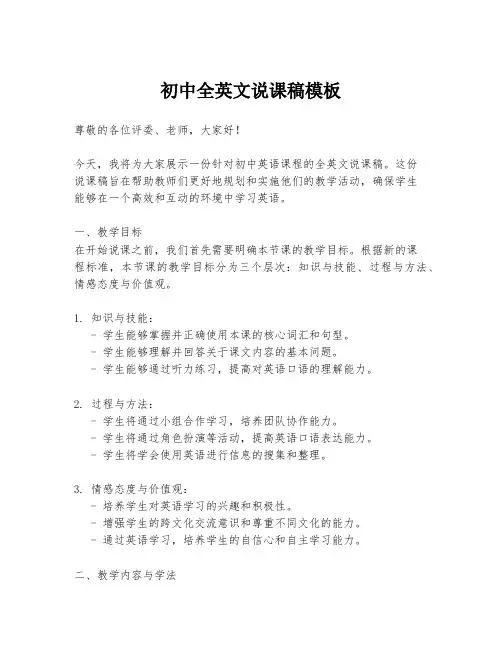
初中全英文说课稿模板尊敬的各位评委、老师,大家好!今天,我将为大家展示一份针对初中英语课程的全英文说课稿。
这份说课稿旨在帮助教师们更好地规划和实施他们的教学活动,确保学生能够在一个高效和互动的环境中学习英语。
一、教学目标在开始说课之前,我们首先需要明确本节课的教学目标。
根据新的课程标准,本节课的教学目标分为三个层次:知识与技能、过程与方法、情感态度与价值观。
1. 知识与技能:- 学生能够掌握并正确使用本课的核心词汇和句型。
- 学生能够理解并回答关于课文内容的基本问题。
- 学生能够通过听力练习,提高对英语口语的理解能力。
2. 过程与方法:- 学生将通过小组合作学习,培养团队协作能力。
- 学生将通过角色扮演等活动,提高英语口语表达能力。
- 学生将学会使用英语进行信息的搜集和整理。
3. 情感态度与价值观:- 培养学生对英语学习的兴趣和积极性。
- 增强学生的跨文化交流意识和尊重不同文化的能力。
- 通过英语学习,培养学生的自信心和自主学习能力。
二、教学内容与学法接下来,我将介绍本节课的教学内容和学法。
1. 教学内容:- 课文主题:介绍一种学生感兴趣的文化现象或社会问题。
- 核心词汇:列出与课文主题相关的5-10个新词汇。
- 重点句型:介绍2-3个与课文内容相关的实用句型。
2. 学法指导:- 通过图片、视频等多媒体材料,激发学生的学习兴趣。
- 利用思维导图等工具,帮助学生整理和记忆新词汇。
- 通过情景模拟和角色扮演,让学生在实践中学习和使用英语。
三、教学过程本节课的教学过程分为以下几个阶段:1. 导入新课- 通过一个与课文主题相关的小故事或问题,吸引学生的注意力,并引入新课内容。
2. 呈现新知- 教师清晰地呈现新词汇和句型,并提供例句。
- 学生跟读并模仿教师的发音,确保语音语调的准确性。
3. 练习与应用- 学生通过填空、连线等练习,巩固新词汇和句型。
- 小组合作,进行角色扮演或情景对话,将所学知识应用于实际交流中。

初中英语说课稿优秀7篇初中英语说课稿篇一各位评委老师,大家好!今天我说课的题目是初中英语第二册Unit 6 Holidays,整个说课我将分四部分进行讲述,即教材分析、教法、学法、教学程序。
一、说教材本单元主要围绕谈论节日里所做的事情这一话题展开教学。
这一单元的内容体现了浓郁的东西方文化特点,是一个学生十分感兴趣的话题。
这里涉及了十个东西方节日,和三个四会句型及一个三会句型。
我根据学生的实际情况,选取了New Years Day,Spring Festival,May Day,Childrens Day,National Day五个节日,及三个四会句型和一个三会句型作为第一教时的教学内容。
在这些节日里,只有Spring Festival是学生没接触过的,其余四个节日学生都或多或少接触过了,因此我将节日中人们的活动及四个句型作为教学的重点和难点来处理。
在句型的操练过程中,让学生感受东西方文化的特点。
二、说教法1.英语学习的目的重在更好地运用语言于实际的交流之中,单调地重复课文内容或机械地操练吸引不了我们的学生。
为达到交流的目的,我采用情境教学法、直观教学法,在课堂上我尽量创设真实或比较真实的语言交流情境,让学生在情境中进行语言交流,从而习得语言。
2.结合本课的句型特点和重点,我在教学中,主要选用合作学习的教学方式,引导学生自主学习,使之成为学习的主人。
为学生营造一个民主、生动、活泼的学习环境,使学生主动参与到探究过程当中,培养学生的创新意识和自学能力。
三、说学法根据教材和学生的认知水平,使学生在不断参与竞争、团结合作的互动环节中渗透你才是学习的主人的意识,培养学生自主学习的能力和意识,使学生学到的是学习的方法,提高的是学习的能力。
四、说教学过程(一)词不离句,句不离境在英语教学中提倡习得。
习得是指由于处于某种语言环境而随意地学得此语言的潜意识过程;而学习往往是指有意识的学习过程。
我在教学过程中做到词不离句,句不离境,注重让学生在语言环境中自然而然习得语言。
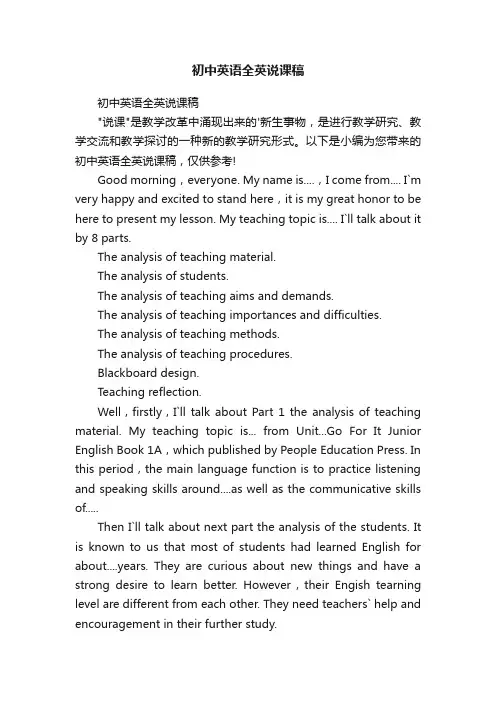
初中英语全英说课稿初中英语全英说课稿"说课"是教学改革中涌现出来的'新生事物,是进行教学研究、教学交流和教学探讨的一种新的教学研究形式。
以下是小编为您带来的初中英语全英说课稿,仅供参考!Good morning,everyone. My name is....,I come from.... I`m very happy and excited to stand here,it is my great honor to be here to present my lesson. My teaching topic is.... I`ll talk about it by 8 parts.The analysis of teaching material.The analysis of students.The analysis of teaching aims and demands.The analysis of teaching importances and difficulties.The analysis of teaching methods.The analysis of teaching procedures.Blackboard design.Teaching reflection.Well,firstly,I`ll talk about Part 1 the analysis of teaching material. My teaching topic is... from Unit...Go For It Junior English Book 1A,which published by People Education Press. In this period,the main language function is to practice listening and speaking skills around....as well as the communicative skills of.....Then I`ll talk about next part the analysis of the students. It is known to us that most of students had learned English for about....years. They are curious about new things and have a strong desire to learn better. However,their Engish tearning level are different from each other. They need teachers` help and encouragement in their further study.Next I`ll talk about teaching aims and demands. There are knowledge aims,ability aims and emotional aims. The knowledge aims are to enable the students to master the new words.....the phrases....and the sentenses.....The ability aims are to obtain the abilities of listening,speaking,reading and writing around.....to train the students` abilities of using language,to guide the students to talk ing the expressions of....and to develop the students` ability of creative thinking and cooperative study. The emotional aims are to enable.....Let`s move on to another part: the analysis of teaching importances and difficulties. The teaching importances are....The teaching difficulties are.....Next is teaching methods. I use...methods in my lesson. There are multimedia computer assisted instruction,task-based activities,situational approach,total physical response or the audio-lingual method.Now I`ll talk about teaching procedures. According to five steps teaching method,I design my lesson into five steps.Step 1 is warm-up. Here I`ll....By this,the students can be interested in it and pay their attention to our class easily and....Step 2 is lead-in. Here I`ll....By this,the students.....Step 3 is presentation. Here I`ll.....By this,the students......Step 4 is practice. Here I`ll....By this,the students......Step 5 is homework. Here I`ll......By this ,the students.....Next is my blackboard design. I`ll design it like this.....At last,I want to say,to be a good teacher is my dream. I think a teacher is not only a guide for sudents,but also a friend of them. If I were a teacher,I would build a close relation with my students,helping them not only on their study but also on their lives. I`ll try my best,and I have confident that I can do it.Ok,that`s all. Thanks for your listening. Good-bye.。
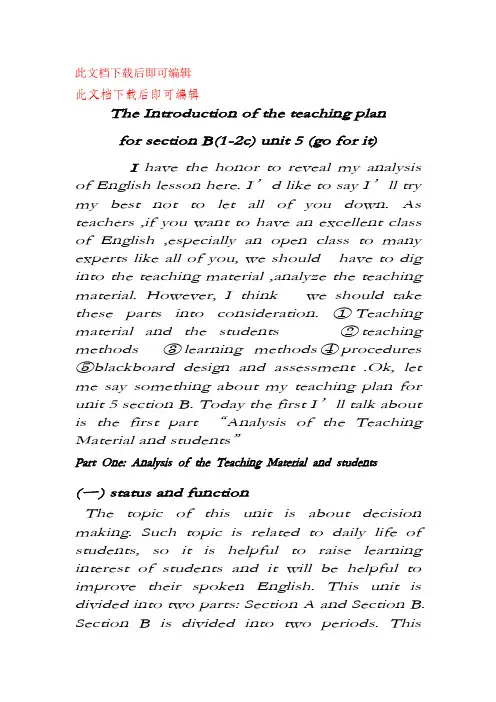
此文档下载后即可编辑此文档下载后即可编辑The Introduction of the teaching planfor section B(1-2c) unit 5 (go for it)I have the honor to reveal my analysis of English lesson he re. I’d like to say I’ll try my best not to let all of you down. As teachers ,if you want to have an excellent class of English ,especially an open class to many experts like all of you, we should have to dig into the teaching material ,analyze the teaching material. However, I think we should take these parts into consideration. ①Teaching material and the students ②teaching methods ③learning methods④procedures ⑤blackboard design and assessment .Ok, let me say something about my teaching plan for unit 5 section B. Tod ay the first I’ll talk about is the first part “Analysis of the Teaching Material and stud ents”Part One: Analysis of the Teaching Material and students(一) status and functionThe topic of this unit is about decision making. Such topic is related to daily life of students, so it is helpful to raise learning interest of students and it will be helpful to improve their spoken English. This unit is divided into two parts: Section A and Section B. Section B is divided into two periods. Thisperiod is the first lesson of Unit5 section B. It introduces new vocabulary while recycling the language presented in Section A. All activities help students integrate the new target language with the language studied in Section A. This recycling reinforces previous language learning while providing additional practice with newly learned language. It also increases the students listening and speaking ability by listening practice and pair work talking(二) Teaching Aims and DemandsThe teaching aims basis is established according to Junior School English syllabus provision. In accordance with the analysi s of teaching material and the requirements of “go for it"English teaching syllabuses. The focus of teaching should be laid on g rasping key vocabulary and structures, and developing the students’ability of commu nication. So I’vedesigned the following aims and demands1. Knowledge objectsKey vocabulary:agent; make money;travel around the world; g et an educationTarget language:I think you should go to coll egeBut if I go to college, I’ll never become a great soccer player.2. Ability objects:To trai n students’ ability of listening and speakingTo train students’ ability of communicatio n3. Moral objects:Money isn’t everything.To be interested in taking part in activities in English class(三)Teaching key points and difficult points1. Key points:key phrases:travel around the world; make money; get an educationkey structures:I think you should (I)I… I’ll never…2. Difficult points:how to train and improve students’ lis tening ability.(四) Analysis of the studentsThe Ss has learned English for about two years so far. Although they are all fro m the rural area, they can understand some words and some simple sentences. T he Ss have taken a great interest in English now.1. The student s don’t have large vocabular y.2. The students seldom communicate in English in normal times.3. The students are lacking in listening and speaking skills.4. The gap of the Ss’knowledge level in the same class is quite wide(五) Teaching aidsMulti-media computer, Tape recorder, some money and so on. They will be needed in this lesson.Part Two The Teaching Methods1. Communicative teaching method2. listening and speaking methods3. Task-based teaching methodAs we all know,the main instructional aim s of learning English in the Junior Middl e School is to train students’abilities of listening, speaking, reading, writing and t heir good sense of the English language S o in this lesson I’ll mainly use “Commu nicative teaching method” ,“liste ning an d speaking teaching method ”and “Task-based”teaching method. That is to say, I’ll let the Ss get a better understa nding of the key structure of the dialogue. I’ll give the Ss some tasks and arrange s ome activities: free talking, listening and a nswering , oral practice, acting out and h aving a competition. Above all, I will let the Ss learn in real situations, finish a task by making a survey to help the Ss to get a better understanding of the key structu re of the conversation.Part Three The Learning Method─cooperationThe students will finish some tasks in limited time to improve their listening and speaking skills. The students will take part in some activities like working in pairs, discussing in pairs. Each unit in “Go for it”contains pair work, group work and games. The students who sit at the same table and groups can make a discussion and learn each other. It makes each student be relaxed. They needn’t worry about making mistakes.It can arouse students to think and to say what they want to say. Study will become more relaxed and pleased in this kind of environment.Part Four Teaching Procedure一Teaching stepsStep 1 Leading inT: Good morning, boys and girls!Ss: Good morning, sir!T: (Take out a piece of bill) Look! What’s this?Ss: Money.T: Who likes it? Hands up?Ss: (Ss all put up their hands)T: (kiss the money) me, too. (Put the bill in thepocket)Ss: (Ss all laugh)T: (Show a man who is holding plenty of money)Ss: Wow.T: If I have so much money, I will give some to the poor students in our class, and if they work hard, I will give them more. If you have so much money, what will you do? Work in pairs and talk about it.(Students are talking about it in pairs; they have enough words to say)…(Talk about the question with many students.) T: S1, If you have so much money, what will you do?S1: If I have so much money, I will give some money to my parents.T: You are so kind. Don’t you want to travel around the world?( translate into Chinese if necessary; Teach: travel around the world)S1: I think I will.T: S2, what about you?S2: If I have so much money, I will buy some new clothes for my parents. They are very hard-working.T: That’s a good idea. Don’t you want to get an education? (Translate into Chinese if necessary; teach: get an education)S2: Yes, I am sure I will go to college.T: If you work hard, I think you will go to college.S2: I think so.T: S3, if you have so much money, what will you do?S3: I will open up a company and make more money.T: That’s great. May you success!S3: Thank you.( Ask more students to talk about it )…T: If we have so much money, we will do a lot of things with the money. So money is very important for us; S4, do you think money is everything? (Translate into Chinese if necessary)S4: I think money isn’t everything.T: I agree with you. Money isn’t everythi ng.Purpose of my designing:I think it is imp ortant to form a better English learning s urrounding for the Ss and at the same tim e it is necessary to provide situations to re view learned knowledge for the next step and present some new words and phrases. Step 2 Study the phrasesT shows the phrases in Activity 1 and let Ss read and learn.Step 3 Circle and survey1. T: Look at the things in Activity 1, which of the things are the most important to you? Circle three things.(Ss circle. Wait for a moment)T: What is the most important thing to you?S5: To go to college.( help if necessary)T: What’s the second?S5: …T: What’s the third?S5: …(Ask more students to say)2. T: Please work in groups of six, and count up the number of the students in your group, then fill in the chart.in each group and Show the most students in each item._____ think _____ is the most important thing to them, ______ think _____ is the second important thing to them, and _____ think _____ is the third important thing to them.Purpose of my designing:To provide situations to review learned knowledge for the next step listening and make sure the Ss can grasp the key words and phrases and learn toexpress their own opinionStep 4 Listen and write “A” or “P”T: Look at the pictures in Activity 2a, we can see two pictures, the first picture is about Michael and a soccer agent (teach: agent), and the second picture is about Michael and his parents. And we will hear two conversations, Conversation One is about Michael and the soccer agent, Conversation Two is about Michael and his parents. Listen to the recording and write “A” or “P” in the blanks.A----- a soccer agentP----- Michael’s parents(Make sure they know the letters’ meaning) (T plays the recording for the first time, Ss listen. T plays the recording for the second time, Ss write “A” or “P”)Correct the answers with the students.Purpose of my designing: to give students practice n the target languages in spoken conversationStep 5 Listen and completeT: Look at the sentences in Activity 2b, read the sentences first.(Students read loudly)T: Listen to the recording, Listen to the first sentence as a model. (Play the recording; let them know the first sentence) now please complete the other sentences)(Continue playing the recording, Ss matchthe other sentences)Correct the answers with the students.Let Ss read the typescripts on Page 89 Section B 2a, 2b.Purpose of my designing: in order to give students additional listening practiceStep 6 giving some adviceT: (Show a picture of the Lions) Look at the picture, the Lions are great teams and won a lot of gold medals. They are very famous. But Michael can’t decide whether he will join the Lions, what should he do? If you are Michael, your classmates are giving you some advice, how about the advice? Write down the consequence.Ss work in pairs and fill the chart.Ask some students to say.Example:Zhang Ming thinks I should become a Lion, if I become a lion, I will be happy. But Chen Li thinks I should go to college, if I go to college, I won’t become a soccer player. Lu Ting thinks I shouldn’t Join the Lions, if I join the Lions, I won’t be famous.Purpose of my designing: this task is to guide oral practice using the target language. “Task-based” teaching method is used here to develop the Ss’ ability of communication and also their ability of cooperation will be well trained. Tell the Ss how to make decisions and talk about consequences according to the listening material .I think proper competition can arouse the Ss’ interest in English learning. If the Ss can finish this task well, they will benefit a lot in their spoken English.Step 7. Summary and homework. Summarize what they have learned in this period. Ask the students : what job do you want to do in the future ? do you want to be famous ?do you like to make a lot of money? go on discussing after class.Purpose: It’s important for students to speak English as much as possible in class or after class. It’s necessary for them to do some extensive exercise after class to consolidate the knowledge they learned.Part Four:Blackboard Design and AssessmentHow to use the blackboardAssessmentThe valuation of my teachingMy students are real masters in class. With the help of the tasks and activities, it's easy to learn and understand the content. Training the students oral and speaking ability is another character. All my students have chances to practice their listening and oral English. 95℅of them can master the content. They are lack of vocabulary, so they need give us many new ideas by sample conversations.。
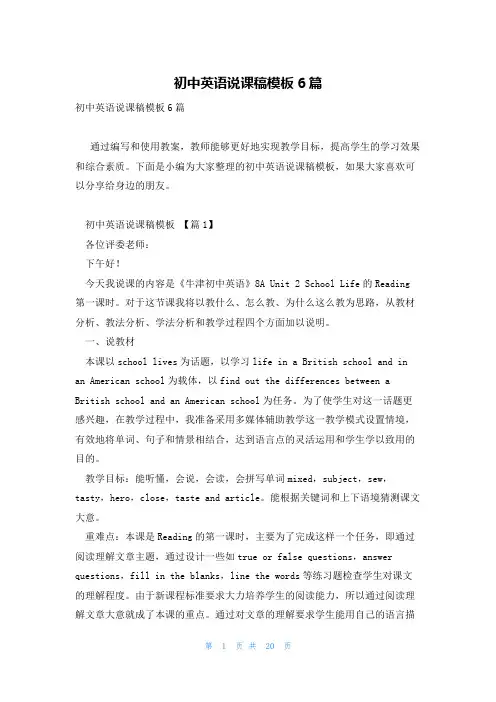
初中英语说课稿模板6篇初中英语说课稿模板6篇通过编写和使用教案,教师能够更好地实现教学目标,提高学生的学习效果和综合素质。
下面是小编为大家整理的初中英语说课稿模板,如果大家喜欢可以分享给身边的朋友。
初中英语说课稿模板【篇1】各位评委老师:下午好!今天我说课的内容是《牛津初中英语》8A Unit 2 School Life的Reading 第一课时。
对于这节课我将以教什么、怎么教、为什么这么教为思路,从教材分析、教法分析、学法分析和教学过程四个方面加以说明。
一、说教材本课以school lives为话题,以学习life in a British school and in an American school为载体,以find out the differences between a British school and an American school为任务。
为了使学生对这一话题更感兴趣,在教学过程中,我准备采用多媒体辅助教学这一教学模式设置情境,有效地将单词、句子和情景相结合,达到语言点的灵活运用和学生学以致用的目的。
教学目标:能听懂,会说,会读,会拼写单词mixed,subject,sew,tasty,hero,close,taste and article。
能根据关键词和上下语境猜测课文大意。
重难点:本课是Reading的第一课时,主要为了完成这样一个任务,即通过阅读理解文章主题,通过设计一些如true or false questions,answer questions,fill in the blanks,line the words等练习题检查学生对课文的理解程度。
由于新课程标准要求大力培养学生的阅读能力,所以通过阅读理解文章大意就成了本课的重点。
通过对文章的理解要求学生能用自己的语言描述出相关内容,这就是本课的难点。
二、说教法1.直观情境教学法:本课将利用多媒体创设情境,激发学生的好奇心和求知欲;设置语境,使学生体验语言的真实、自然,从而培养学生组织和表达语言的能力。
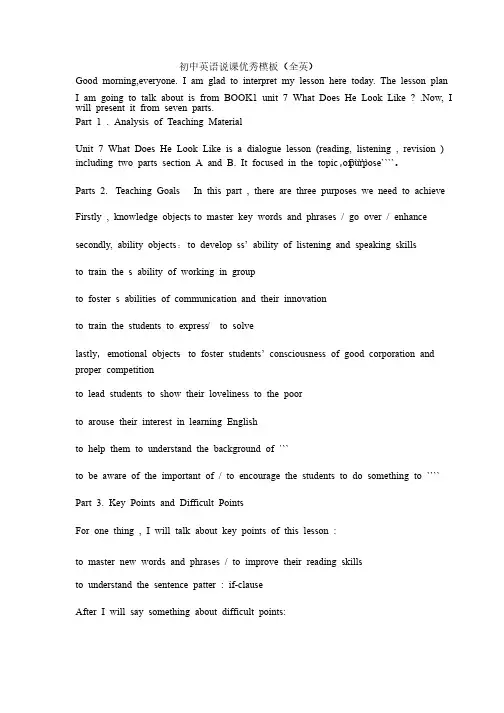
初中英语说课优秀模板(全英)初中英语说课优秀模板(全英)Good morning,everyone. I am glad to interpret my lesson here today. The lesson plan I am going to talk about is from BOOK1 unit 7 What Does He Look Like ? .Now, I will present it from seven parts. Part 1 . Analysis of Teaching Material Unit 7 What Does He Look Like is a dialogue lesson (reading, listening , revision ) including two parts section A and B. It focused in the topic of`````,purpose````。
Parts 2. Teaching Goals In this part , there are three purposes we need to achieve Firstly , knowledge objects:to master key words and phrases / go over / enhance secondly, ability objects :to develop ss’ ability of listening and speaking skillsto train the s ability of working in group to foster s abilities of communication and their innovation to train the students to express / to solve lastly,emotional objects:to foster students’ consciousness of good corporation and proper competition to lead students to show their loveliness to the poor to arouse their interest in learning English to help them to understand the background of ``` to be aware of the important of / to encourage the students to do something to ```` Part 3. Key Points and Difficult Points For one thing , I will talk about key points of this lesson : to master new words and phrases / to improve their reading skills to understand the sentence patter : if-clause After I will say something about difficult points: to develop their communicative Part 4. Analysis of Students These students who have come into middle school recently. They are exposed to English for the first time ,so it is very important to develop their keen interest in English . It is necessary to use assistant teaching methods to arouse their attention。
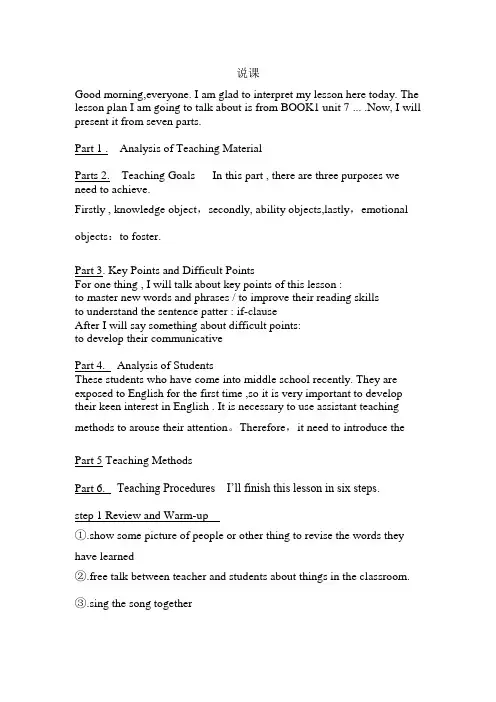
说课Good morning,everyone. I am glad to interpret my lesson here today. The lesson plan I am going to talk about is from BOOK1 unit 7 ... .Now, I will present it from seven parts.Part 1 . Analysis of Teaching MaterialParts 2. Teaching Goals In this part , there are three purposes we need to achieve.Firstly , knowledge object,secondly, ability objects,lastly,emotional objects:to foster.Part 3. Key Points and Difficult PointsFor one thing , I will talk about key points of this lesson :to master new words and phrases / to improve their reading skillsto understand the sentence patter : if-clauseAfter I will say something about difficult points:to develop their communicativePart 4. Analysis of StudentsThese students who have come into middle school recently. They are exposed to English for the first time ,so it is very important to develop their keen interest in English . It is necessary to use assistant teaching methods to arouse their attention。
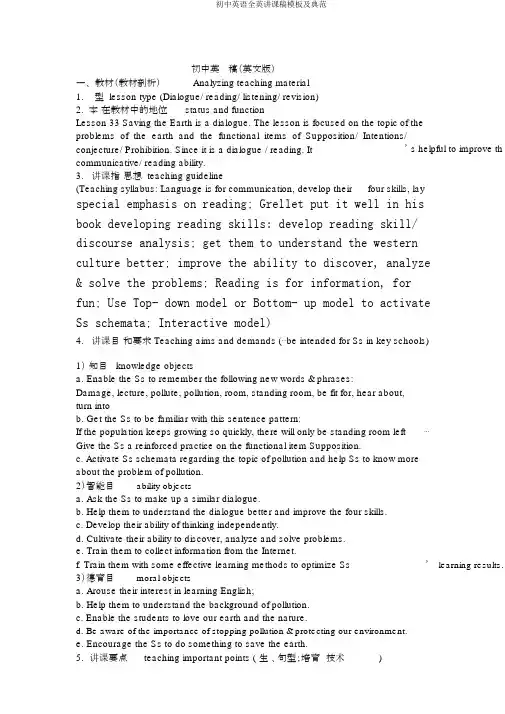
初中英稿(英文版)一、教材(教材剖析)Analyzing teaching material1.型 lesson type (Dialogue/ reading/ listening/ revision)2.本在教材中的地位status and functionLesson 33 Saving the Earth is a dialogue. The lesson is focused on the topic of theproblems of the earth and the functional items of Supposition/ Intentions/conjecture/ Prohibition. Since it is a dialogue / reading. It’ s helpful to improve th communicative/ reading ability.3.讲课指思想 teaching guideline(Teaching syllabus: Language is for communication, develop their four skills, layspecial emphasis on reading; Grellet put it well in hisbook developing reading skills: develop reading skill/discourse analysis; get them to understand the westernculture better; improve the ability to discover, analyze& solve the problems; Reading is for information, forfun; Use Top- down model or Bottom- up model to activateSs schemata; Interactive model)4.讲课目和要求 Teaching aims and demands (⋯be intended for Ss in key schools)1)知目 knowledge objectsa. Enable the Ss to remember the following new words & phrases:Damage, lecture, pollute, pollution, room, standing room, be fit for, hear about,turn intob. Get the Ss to be familiar with this sentence pattern:If the population keeps growing so quickly, there will only be standing room left⋯Give the Ss a reinforced practice on the functional item Supposition.c. Activate Ss schemata regarding the topic of pollution and help Ss to know moreabout the problem of pollution.2)智能目ability objectsa. Ask the Ss to make up a similar dialogue.b. Help them to understand the dialogue better and improve the four skills.c. Develop their ability of thinking independently.d. Cultivate their ability to discover, analyze and solve problems.e. Train them to collect information from the Internet.f. Train them with some effective learning methods to optimize Ss’learning results. 3)德育目moral objectsa. Arouse their interest in learning English;b. Help them to understand the background of pollution.c. Enable the students to love our earth and the nature.d. Be aware of the importance of stopping pollution & protecting our environment.e. Encourage the Ss to do something to save the earth.5. 讲课要点teaching important points ( 生、句型;培育技术)a. New words and phrasesb. Sentence pattern: If- clausec. improve their reading skills.d. Talking about problems of the Earth.6. 说讲课难点teaching difficult points ( 语法;发展交际能力 )a. functional item: Supposition.b. Develop their communicative ability. Act out their own dialogue.7. 说教具teaching aids (multi-media computer, software, OHP)The teaching syllabus says that it ’necessary for teachers to use modern teachingfacilities. It ’ofs great help to increase the class density and improve our teachingresult. It can also make the Ss reach a better understanding of the text by making theclasses lively and interesting. At the same time, it arouses the Ss’interest in lea English.二、说教法Teaching methodsFive step method; audio-video; communicative approach;Task-basedlearning: New Syllabus Design encourages teachers to use this teachingmethod. TBLT can stimulate Ss’initiative in learning and develop their ability inlanguage application. Make the Ss the real masters in class while the teacherhimself acts as the director and bring their ability into full play.三、说学法Study methods1.Teach Ss how to be successful language learners.2.Teach Ss how to develop the reading skill — skim & scan; how to communicatewith others; how to learn new words; how to learn independently;3.Get the Ss to form good learning habits.四、说讲课过程Teaching proceduresI. 复习 (Revision) 5min (Daily report; 词汇 diagram; brainstorming; activateschemata)Activity 1: Imagination1). Suppose a bottle of ink is turned over and dirties your white shirt, what is to bedone? (Wash it? Or throw it away?)2). Suppose you catch a bad cold, what’ s to be done?3). Suppose your bike is broken, what’ s to be done?4). And suppose the earth, on which we all live, is damaged, what’ s to be done? * What can you think of when you see“ pollutiw o rd?(waste,n”this environment, air,water, factory, desert, climate... Try to activate the Ss schemata regarding the topicof pollution.)II.表现 (Presentation) 5minActivity 2: PresentationPlay the song “ Earth Song ” sung by Michael Jackson. (Create anre)atmospheA lot of pictures and video clips about the causes and results of the three problemsmentioned in this lesson will be shown on the screen with the help of the computer.Ss’ presentation on pollution. Attract their attention, arouse their interest,andcreate a good atmosphere for communication.*Activate their schemata and cultivate their ability in collecting information fromthe Internet and develop their ability in thinking independently.III. 对话 / 阅读 (Dialogue)18m 1.Pre- readingActivity 3: Prediction初中英语全英讲课稿模板及典范1st listening/ fast reading, one guided Q to help Ss to get the main idea:What do you think is discussed at the conference?2. While- readingActivity 4: Read and answer2nd listening/ careful reading, more Qs to get the detailed information. Develop their reading skills: skim & scan. Pay attention to the pronunciation, stress & intonation.*阅读 : Pre-reading; while-reading; post-reading (fast reading/ careful reading; skim/ scan; 鉴别要点词 key words;确立主题句;创办信息差 information gap;T or F; 填表格 chart/diagram; Predicting; Make a timeline; Make a story map 。
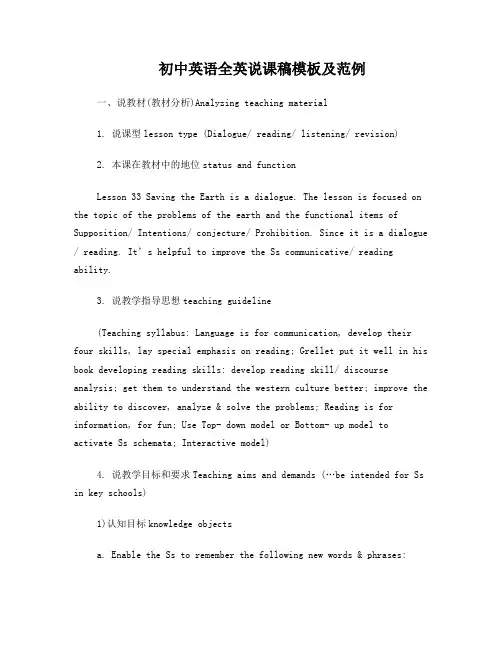
初中英语全英说课稿模板及范例一、说教材(教材分析)Analyzing teaching material1. 说课型lesson type (Dialogue/ reading/ listening/ revision)2. 本课在教材中的地位status and functionLesson 33 Saving the Earth is a dialogue. The lesson is focused on the topic of the problems of the earth and the functional items of Supposition/ Intentions/ conjecture/ Prohibition. Since it is a dialogue / reading. It’s helpful to improve the Ss communicative/ reading ability.3. 说教学指导思想teaching guideline(Teaching syllabus: Language is for communication, develop their four skills, lay special emphasis on reading; Grellet put it well in his book developing reading skills: develop reading skill/ discourse analysis; get them to understand the western culture better; improve the ability to discover, analyze & solve the problems; Reading is for information, for fun; Use Top- down model or Bottom- up model toactivate Ss schemata; Interactive model)4. 说教学目标和要求Teaching aims and demands (…be intended for Ss in key schools)1)认知目标knowledge objectsa. Enable the Ss to remember the following new words & phrases:Damage, lecture, pollute, pollution, room, standing room, be fit for, hear about, turn intob. Get the Ss to be familiar with this sentence pattern:If the population keeps growing so quickly, there will only be standing room left…Give the Ss a reinforced practice on the functional item Supposition.c. Activate Ss schemata regarding the topic of pollution and helpSs to know more about the problem of pollution.2)智能目标ability objectsa. Ask the Ss to make up a similar dialogue.b. Help them to understand the dialogue better and improve the four skills.c. Develop their ability of thinking independently.d. Cultivate their ability to discover, analyze and solve problems.e. Train them to collect information from the Internet.f. Train them with some effective learning methods to optimizeSs’learning results.3)德育目标moral objectsa. Arouse their interest in learning English;b. Help them to understand the background of pollution.c. Enable the students to love our earth and the nature.d. Be aware of the importance of stopping pollution & protectingour environment.e. Encourage the Ss to do something to save the earth.5. 说教学重点teaching important points (生词、句型;培养阅读技能)a. New words and phrasesb. Sentence pattern: If- clausec. improve their reading skills.d. Talking about problems of the Earth.6. 说教学难点teaching difficult points (语法;发展交际能力)a. functional item: Supposition.b. Develop their communicative ability. Act out their own dialogue.7. 说教具teaching aids (multi-media computer, software, OHP)The teaching syllabus says that it’s necessary for teachers to use modern teaching facilities. It’s of great help to increase the class density and improve our teaching result. It can also make the Ss reach a better understanding of the text by making the classes lively andinteresting. At the same time, it arouses the Ss’interest in learning English.二、说教法Teaching methodsFive step method; audio-video; communicative approach;Task-based learning: New Syllabus Design encourages teachers to use this teaching method. TBLT can stimulate Ss’initiative in learning and develop their ability in language application. Make the Ss the real masters in class while the teacher himself acts as the director and bring their ability into full play.三、说学法Study methods1. Teach Ss how to be successful language learners.2. Teach Ss how to develop the reading skill —skim & scan; how to communicate with others; how to learn new words; how to learn independently;3. Get the Ss to form good learning habits.四、说教学过程Teaching proceduresI. 复习(Revision) 5min (Daily report; 词汇diagram; brainstorming; activate schemata)Activity 1: Imagination1). Suppose a bottle of ink is turned over and dirties your white shirt, what is to be done? (Wash it? Or throw it away?)2). Suppose you catch a bad cold, what’s to be done?3). Suppose your bike is broken, what’s to be done?4). And suppose the earth, on which we all live, is damaged,what’s to be done?* What can you think of when you see “pollution”this word?(waste, environment, air, water, factory, desert, climate... Try to activate the Ss schemata regarding the topic of pollution.)II. 呈现(Presentation) 5minActivity 2: PresentationPlay the song “Earth Song”sung by Michael Jackson. (Create an atmosphere)A lot of pictures and video clips about the causes and results of the three problems mentioned in this lesson will be shown on the screen with the help of the computer.Ss’presentation on pollution. Attract their attention, arousetheir interest, and create a good atmosphere for communication.* Activate their schemata and cultivate their ability in collecting information from the Internet and develop their ability in thinking independently.III. 对话/ 阅读(Dialogue)18m1. Pre- readingActivity 3: Prediction1st listening/ fast reading, one guided Q to help Ss to get the main idea:What do you think is discussed at the conference?2. While- readingActivity 4: Read and answer2nd listening/ careful reading, more Qs to get the detailed information. Develop their reading skills: skim & scan. Pay attention to the pronunciation, stress & intonation.* 阅读: Pre-reading; while-reading; post-reading (fast reading/ careful reading; skim/ scan; 识别关键词key words;确定主题句;创设信息差information gap;T or F; 填表格chart/diagram; Predicting; Make a timeline; Make a story map。
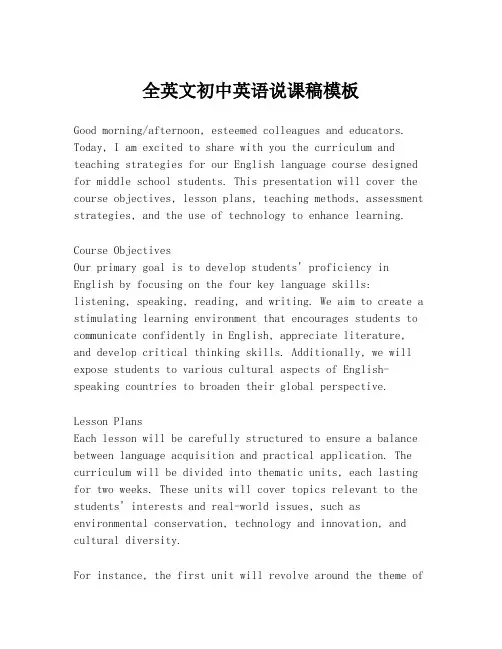
全英文初中英语说课稿模板Good morning/afternoon, esteemed colleagues and educators. Today, I am excited to share with you the curriculum and teaching strategies for our English language course designed for middle school students. This presentation will cover the course objectives, lesson plans, teaching methods, assessment strategies, and the use of technology to enhance learning.Course ObjectivesOur primary goal is to develop students' proficiency in English by focusing on the four key language skills: listening, speaking, reading, and writing. We aim to create a stimulating learning environment that encourages students to communicate confidently in English, appreciate literature, and develop critical thinking skills. Additionally, we will expose students to various cultural aspects of English-speaking countries to broaden their global perspective.Lesson PlansEach lesson will be carefully structured to ensure a balance between language acquisition and practical application. The curriculum will be divided into thematic units, each lasting for two weeks. These units will cover topics relevant to the students' interests and real-world issues, such as environmental conservation, technology and innovation, and cultural diversity.For instance, the first unit will revolve around the theme of'Community and Identity.' Students will read short stories and poems that explore different aspects of community life and personal identity. They will engage in discussions, debates, and collaborative projects to deepen their understanding of the texts and their own perspectives.Teaching MethodsTo foster an interactive and student-centered learning environment, we will employ a variety of teaching methods. These include:1. Task-based Language Teaching (TBLT): Students will work on real-life tasks that require them to use English for specific purposes, such as writing a letter to a local newspaper or creating a presentation on a social issue.2. Communicative Language Teaching (CLT): Through role-plays, simulations, and group activities, students will be encouraged to use English in authentic contexts, promoting natural and fluent communication.3. Integrated Skills Approach: Reading, writing, listening, and speaking skills will be integrated into each lesson, allowing students to see the connection between languageskills and their practical application.Assessment StrategiesAssessment will be ongoing and will include both formative and summative evaluations. Formative assessments, such as class participation, quizzes, and peer reviews, will provide students with immediate feedback to guide their learning.Summative assessments will include单元测试, 期中和期末考试, and a final project that requires students to demonstratetheir mastery of the language skills and content covered inthe course.Technology IntegrationWe will leverage technology to enhance the learningexperience and engage students in modern ways of communication. Our English language lab will provide accessto interactive software for language practice. Additionally, students will use online resources such as educational videos, podcasts, and e-books to broaden their exposure to English.In conclusion, our English language course for middle school students is designed to be both comprehensive and engaging.By focusing on real-world language use, integrating technology, and employing a variety of teaching methods, we aim to equip our students with the skills and confidence they need to excel in an increasingly global society.Thank you for your attention. I am now open to any questionsor suggestions you may have.。
初中英语全英文说课稿模板(精品)Good morning, everyone. I’m No.14.Today I’m very happy here to talk about the topic What should we do ,if we have problems? I’ll divide the instruction into 5 parts.Part1 Analysis of the teaching material:Status and functionThis period is from Section B of unit 10. The teaching content is 2b. This is an important lesson in Book Two. And it is the fourth period of this unit; it talks about what they should do if people have problems. This topic is close to our daily life, It can ar ouse the students’ interests. As a reading part, i t’s really important for students to master some reading skills as well as improve their reading speed. To finish the learning tasks of this lesson, I make out the following three objectives:Knowledge Objectives:1. New words: expert, teenager, normal, certainly, wallet, mile, angry,understanding , careless, mistake, himself, careful,advise, solve, step, trust, experience, halfway2. Key phras es: keep…to oneself, talk to sb, in life, be angry at/about sth. in theend, make mistakes, in the future, run away, the first step, in half,solve a problem, be afraid to do sth, advise sb. to do sth.Ability Objectives:1. D evelop the students’ ability of listening, speaking, reading and writing.2. Train the st udents’ ability of communication.Moral Objectives:Let the students know: Problems and worries are normal in life. If you have any problems, you should talk to other people you trust and find thesolutions.Teaching key points:1. Master the new words and phrases.2. Help the students to develop some useful reading skills.3.Let the students know What they should do if they have problems.Teaching difficult points:1. How to make the students understand the new language items2. How to make the students work well with their partners.Next about Part Two Analysis of the studentsThe Ss of Grade 8 have learned English for more than one and a half years in middle school .So far, They can speak simple English very well. They have mastered some skills of listening , speaking , reading and writing .Most Ss have taken a great interest in English . They enjoy learning English now.(S o much fo r this part, let’s come to Part3)Part3 Analysis of the teaching and learning MethodsI will use the following methods of teaching and learning to achieve the teaching objectives.(1. Analysis of the teaching methods)As for teaching methods:I will use Communicative teaching method and “Task –based’’ teaching method. I give them enough chances to practice, and I will use pair work, group work, memory test and so on to let the students take an active part in all kinds of activities. That is “Learning by doing, learning by using”. Let the students be the masters of the class teaching. Of course during my teaching, I will use CAI to arouse the students’ interest(2、Learning methods)Based on the teaching methods above, I hope Ss can learn some important reading skill s, such as Skimming, Scanning(扫读) ,Detailed reading . Part 4 Analysis of the Teaching proceduresStep1 Pre-reading activities for interest (5mins)Activity1:Listen to a song “Trouble is a friend”.Tell me: What will you do if you are in trouble?Purpose of my designing: In this step ,I’ll let Ss have a free talking . I think free talking is a good way to grasp the attention of Ss and it can make the students happy and relaxed; it will get the Ss and the teacher nearer. It can makepreparation for the following steps as well.Activity2:(5 mins)Lead-in→Learn some information (3 mins)show Ss some pictures to learn the new words and phrases. Then read them and have a memory test.专家保守秘密青少年正常的除非无疑、肯定钱包英里发怒的善解人意的粗心的错误他自己小心地劝告解决步骤相信经验分成两半在中途Purpose of my designing:I think it is easy for Ss to remember words with pictures. It’s a kind of Intuitive learning. At the same time remembering the new words can help the students to read the text easily.Step2→ While –readingHere comes to the reading part .The step can be divided into 2 parts : fast reading and careful reading .<1>Fast reading(2 mins)Read the passage quickly and answer:1)What is Laura’s trouble?2)Did she tell her trouble to her parents?Purpose of my designing: Training Ss’ ability of fast reading and get the points they need.As for <2>Careful reading (23mins)1) Read it again and Match each part of the passage with its headline.Paragraph 1 Robert gives some advices about common problems.Paragraph 2 Laura will share her problem in the future.Paragraph 3 Students these days have a lot of worries.2)Read the passage paragraph by paragraph and answer the flowing questions . Then try to retell it according to the questions.3)Read the phrases and fill in the blanks .Purpose of my designing: Train their reading ability of skimming and scanning then extract specific information in a short given time. Here Ss will learn some useful reading skills: get the main idea according to the first and the last sentence of each paragraph and also some key words. At the same time ,I’ll explain the difficult phrases while checking the answers of the questions . Step 3Group work (5mins)Do a survey and give us a report. (5 mins)Ask some students the following questions. Take notes of their answers.Purpose of my designing: It can ask students to use the target languageto talk about problems with each other. Step 4 SummaryLet the students read the new words and phrases on the blackboard, ask the students “ What should you do if you have problems ?”Purpose of my designing: Review new words and structures Ss learnt.Step 5 A small test : (5 mins)I:单项选择:1.If you want to get higher grades, you_______ study hard .A. wouldB. shouldC. willD. won’t2. She is afraid ______a speech before others.A. to giveB. of giveC. giveD. giving3. He is really ________and he often forget things .A. carefulB. worryC. carelessD. understanding4. Can you give me some ________?A. adviseB. advicesC. advisesD. advice5. ______you have a good sleep, you won’t feel better.A. ifB. WhenC. UnlessD. BeforeII. 改写句子:6. Get up early, or you will be late for school.(改为同义句)You get up early, you late for school. III.根据汉语提示完成句子:7. .最好不要逃避我们的问题。
初中说课稿模板英语全英文Ladies and Gentlemen,Today, I am honored to present my lesson plan for an English class at the junior high school level. The lesson is designed to engage students in active learning and to enhance their language skills through various activities.IntroductionGood morning, class! Today, we will be exploring the world of English literature, specifically focusing on "The Gift of the Magi" by O. Henry. This short story is a classic piece of American literature that teaches us about love, sacrifice, and the true meaning of giving.ObjectivesOur main objectives for this lesson are:1. To understand the plot and characters of the story.2. To analyze the theme of the story and its significance.3. To improve reading comprehension and vocabulary.4. To encourage critical thinking and discussion skills.Materials NeededFor this lesson, we will need:- Copies of "The Gift of the Magi" for each student.- Whiteboard and markers.- Handouts with vocabulary words and comprehension questions. - A projector to display images or videos related to the story.Procedure1. Warm-up Activity (5 minutes): We will start with a quick vocabulary match game to review words related to the story. This will set the stage for our reading and discussion.2. Reading (20 minutes): Students will read the story silently, taking notes on the characters, plot, and any unfamiliar words.3. Vocabulary Review (10 minutes): After reading, we will review the vocabulary handout, ensuring that students understand the meaning of new words.4. Comprehension Check (10 minutes): We will go through the comprehension questions to ensure that students have grasped the main ideas of the story.5. Discussion (15 minutes): In pairs or small groups, students will discuss the theme of the story, the sacrifices made by the characters, and what they learned about the value of giving.6. Creative Writing (15 minutes): Students will write a short paragraph or a dialogue inspired by the story, focusing on a similar situation where they had to make a sacrifice forsomeone they cared about.7. Wrap-up (5 minutes): We will conclude the lesson by summarizing the key points discussed and reflecting on the importance of the story's message.AssessmentStudents will be assessed based on their participation in the discussion, the quality of their creative writing, and their understanding of the story's theme and vocabulary.ConclusionIn conclusion, this lesson aims to not only improve students' English language skills but also to impart valuable life lessons through the power of literature. I believe that by the end of this lesson, students will have a deeper appreciation for the story and its underlying message.Thank you for your attention, and I look forward to afruitful and engaging lesson.[End of Lesson Plan]。
Good afternoon, everyone. I’m Cui Haiy an. I’m very hap[py to stand here and share my ideas with you. Now I’ll say Unit 6 This is my sister in Book One. I’ll prepare to say this lesson from four parts.Part One Analysis of the Teaching Material(一) STATUS AND FUNCTION1.This is a very important part in Book One. From this unit , To attain “four skills” request of listening, speaking, reading and writing. To start listing “Word Bank” and tell the Ss to remember the new words. To start asking the Ss to write the English sentences well.2.This lesson is the first one of Unit 6.So if the Ss can learn it well, it will be helpful to make the Ss learn the rest of this unit.3.Such a topic is related to daily life, so it is helpful to raise learning interests of students and it will be also helpful to improve their spoken English.(二)ANALYSIS OF THE STUDENTSThe Ss has learned English for about 2 months so far. They can understand some words and some simple sentences. The Ss have taken a great interest in Engli sh now. (三)TEACHING AIMS AND DEMANDSThe teaching aim's basis is established according to Junior School English syllabus provision.1.Knowledge objects(1) To make the Ss know how to use the affirmative sentence “This is. . . .” and the plurul sentence “These are t….”(2) To study the new words:father mother sister,brother,grandfather,grandmother,friend”, etc. by learning the dialogue of this lesson.2.Ability objects(1) To develop the Ss’ abilities of listening, speaking, reading and writing.(2) To train the Ss’ ability of working in pairs.(3) To develop the Ss’ abilities of communication by learning the useful structures.3.Moral objects(1) To enable the Ss to be polite and love our families.(2) To enable the Ss to cherish the life well.(四)TEACHING KEY AND DIFFICULT POINTS1.Key points:(1).To help the Ss to communicate with each other.(2).To enable the Ss to study in groups and co-operate skillfully.(3).To develop the Ss’ interest in English.2.Difficult points:(1) How to make dialogues and act them out.(2) How to write the right whole sentences.(五) TEACHING AIDSMulti-media computer, Tape recorder, Software: Powerpoint or Authorware, some pictures and so on. They will be needed in this lesson.Part Two The Teaching Methods1. Communicative teaching method2. Audio-visual teaching method3. Task-based” teaching methodAs we all know: the main instructional aims of learning English in the Middle School is to cultivate students’ abilities of listening, speaking, reading, wri ting and their good sense of the English language. So in this lesson I’ll mainly use “Communicative” teaching method, “Audio-visual” teaching method and “Task-based” teaching method. That is to say, I’ll let the Ss to get a better understanding of the key structure of the dialogue. I’ll give the Ss some tasks and arrange five kinds of activities: talking, guessing games, watching CAI, acting out Sample A and having a competition.Teaching special featuresTo use these methods are helpful to develop the Ss’ thought.Part Three STUDYING WAYS1.Teach the Ss how to be successful language learners.2.Let the Ss pass \"Observation—Imitation—Practice \" to study language.3.Teach the Ss how to master dialogues and how to communicate with others.Teaching special features:Let the Ss communicate with each other and adopt competition methods to develop the Ss’ keen interest in English.Part Four Teaching ProcedureI’ll finish this lesson in four steps. First I’ll divide the Ss into four groups and bring a co mpetition into the class. At last let’s see which group is the winner.Step1 Warm-up1. Free talk between T and Ss .Such as: Hi, I’m . . . . What’s your name?This is …. How do you do?Who is he/she? How are you?Who can count from 1to 5?What’s th is in English? etc.2.A game: Ask the Ss to give T some school things. For example:T: Give me your book.(ruler, box, pen, table, knife, etc.)T: This is your book. This is not my book. It’s your book. etc.In this course I’ll ask them to make a dialog ue group by group without repetition. Find out which group will make the most dialogues.Purpose of my designing: I think it is important to form a better English learning surrounding for the Ss by imitating and at the same time it is necessary to provide situations to review learned knowledge.Step2. PresentationThis course is very important. I’ll mainly talk about this step.I’ll use CAI to present the whole dialogue. Arrange some situations to help Ss understand Sample A.First scene: There is a bag on the floor. B is picking it up and get ready to leave. Now A is talking with B.A: Hi, B. How are you today?B: I’m fine, thank you. And you?A: I’m fine, too. Oh, this is my bag.B: No, this is not your bag. It’s my bag.A: (Look closely) Oh, I’m sorry.B: That’s all right.(At the same time, C is running up and hitting A.)C: Oh, I’m sorry.A: That’s OK.I’ll write the key points on the Bb while they are watching. After watching, I’ll teach them to read the words and sentences on the Bb. Make sure they can read them well.Purpose of my designing: To present Sample A by CAI is much easier for the Ss to learn and grasp the meanings. CAI can provide a real situation with its sound and picture and it makes the relationships between the Ss better.Step3.PracticeFirst play the tape recorder. Let the Ss listen and imitate the dialogue. Pay attention to their pronunciation and intonation. In this step the Ss are required to practise the Sample in pairs by reading the dialogue aloud. This step is e mployed to make the Ss grasp the Sample .At last I’ll ask the Ss to think hard and act it out with a partner according to Sample A. Then find out which group will act it out well. I’ll give them red stars.Purpose of my designing: This step is employed to make the Ss get the general idea of the dialogue as a whole one. At the same time let the Ss have a chance to practise their listening and spoken ability.Step4.ProductionIn this step I’ll give the Ss a free space to show their abilities.Second scene: The Ss are having a picnic. It’s hot and they take off their coats and put them together. They are singing and dancing, laughing and chatting. After the picnic, they begin to look for their coats. D and E are talking. F and G are talking. etc.After wat ching, I’ll give the Ss some tasks to make similar dialogues without repetition and find out which group will make more dialogues.Purpose of my designing: “Task-based” teaching method is used here to develop the Ss’ ability of communication and also their ability of co-operation will be well trained. Tell the Ss we should be polite and take good care of our things. We should love our life. I think proper competition can arouse the Ss’ interest in English learning. If the Ss can finish this task well, they will benefit a lot in their spoken English.2.Skill 1 Model 1.I’ll ask four Ss of the groups to write these sentences on the Bb in the four lines.Then check their handwriting, correct their mistakes. Find out who will write well and whose handing is the best.3.Finish the Ss’ workbook.Purpose of my designing: To check the knowledge Ss have learned in this lesson.Step5.Homework:(1)Recite the words as many as possible after class.(2)Make a dialogue according to Sample A and write it in the exercise book.Purpose of my designing: I think homework is so important that the Ss should speak English as much as they can in class or after class. It is necessary for the Ss to do some extensive exercises after class to consolidate the knowledge they learned.Blackboard DesignLesson Six Sample ASix This is my….hey This is not your. . . .sorry It’s my. . . . Picture it’s=it is Oh, I’m sorry.that’s=that is That’s all right/OK.各位评委上午好!我是来自于永川第七中学的一名英语教师,我名叫陈妍。
初中英语说课稿范文全英Lesson Plan: Introduction to English Tenses for Middle School StudentsObjective:The primary goal of this lesson is to introduce students to the concept of English tenses and to familiarize them with the basic tenses: simple present, simple past, and simple future. Students will learn to identify and use these tenses correctly in various contexts.Materials:- Whiteboard and markers- Handouts with examples of sentences in different tenses- Timer for timed activities- Interactive activities or games for practiceIntroduction (5 minutes):Start the lesson by asking students what they know about English tenses. Write their responses on the board. Briefly explain that tenses are used to indicate when an action happens.Presentation (15 minutes):1. Introduce the simple present tense by explaining that it is used for habitual actions, general truths, and states. Provide examples such as "I go to school every day" and "The sun rises in the east."2. Move on to the simple past tense, which is used to describe actions that happened in the past. Give exampleslike "Yesterday, I visited my grandparents" and "They played soccer last weekend."3. Finally, introduce the simple future tense, used for actions that will happen in the future. Examples include "I will go to the library tomorrow" and "She will finish her homework tonight."Practice (20 minutes):1. Distribute handouts with sentences in different tenses. Have students identify the tense of each sentence and explain their reasoning.2. Organize students into small groups and have them create sentences using each tense. Encourage them to share their sentences with the class.3. Use a timer for a quick writing activity where students write as many sentences as possible in each tense within a set time limit.Application (10 minutes):1. Present a short story or dialogue with mixed tenses. Have students identify the tenses used and discuss why each tense is appropriate in that context.2. Engage students in a role-play activity where they must use the correct tense based on the scenario provided.Conclusion (5 minutes):Summarize the key points of the lesson by reviewing the different tenses and their uses. Encourage students to practice using these tenses in their daily Englishconversations and writing.Homework:Assign students to write a short paragraph about their daily routine using the simple present tense, a paragraph about a memorable event using the simple past tense, and a paragraph about their plans for the upcoming weekend using the simple future tense.Assessment:Monitor students' participation in class activities and their understanding through the handouts and role-play exercises. Evaluate the homework assignments for correct tense usage and sentence structure.Differentiation:For advanced students, provide more complex sentences and encourage them to use the tenses in creative writing. For students who need extra support, offer additional examples and one-on-one assistance during practice activities.Reflection:After the lesson, reflect on the students' engagement and understanding of the material. Consider what worked well and what could be improved for future lessons on English tenses.。
[说课经验、说课稿](初中英语老师)全英说课稿模板Good morning, everyone. My name is...., I come from.... I`m very happy and excited to stand here, it is my great honor to be here to present my lesson. My teaching topic is.... I`ll talk about it by 8 parts.The analysis of teaching material.The analysis of students.The analysis of teaching aims and demands.The analysis of teaching importances and difficulties.The analysis of teaching methods.The analysis of teaching procedures.Blackboard design.Teaching reflection.Well, firstly, I`ll talk about Part 1 the analysis of teaching material. My teaching topic is... from Unit...Go For It Junior English Book 1A, which published by People Education Press. In this period, the main language function is to practice listening and speaking skills around....as well as the communicative skills of.....Then I`ll talk about next part the analysis of the students. It is known to us that most of students had learned English for about....years. They are curious about new things and have a strong desire to learn better. However, their Engish tearning level are different from each other. They need teachers` help and encouragement in their further study.Next I`ll talk about teaching aims and demands. There are knowledge aims, ability aims and emotional aims. The knowledge aims are to enable the students to master the new words.....the phrases....and the sentenses.....The ability aims are to obtain the abilities of listening, speaking, reading and writing around.....to train the students` abilities of using language, to guide the students to talk ing the expressions of....and to develop the students` ability of creative thinking and cooperative study. The emotional aims are to enable.....Let`s move on to another part: the analysis of teaching importances and difficulties. The teaching importances are....The teaching difficulties are.....Next is teaching methods. I use...methods in my lesson. There are multimedia computer assisted instruction, task-based activities, situational approach, total physical response or the audio-lingual method.Now I`ll talk about teaching procedures. According to five steps teaching method, I design my lesson into five steps.Step 1 is warm-up. Here I`ll....By this, the students can be interested in it and pay their attention to our class easily and....Step 2 is lead-in. Here I`ll....By this, the students.....Step 3 is presentation. Here I`ll.....By this, the students......Step 4 is practice. Here I`ll....By this, the students......Step 5 is homework. Here I`ll......By this ,the students.....Next is my blackboard design. I`ll design it like this.....At last, I want to say, to be a good teacher is my dream. I think a teacher is not only a guide for sudents, but also a friend of them. If I were a teacher, I would build a close relation with mystudents, helping them not only on their study but also on their lives. I`ll try my best, and I have confident that I can do it.Ok, that`s all. Thanks for your listening. Good-bye。
初中英语说课万能模板下午好,亲爱的老师,(鞠的躬)我是X,申请初中的英语老师。
今天,我的话题是X。
为了使我的演讲更加清晰,我将在以下6个方面描述我的想法。
第一部分,分析教学材料这个教训是来自X单位部分,主要讨论X,这样的话题与我们的日常生活密切相关,所以它很容易激发学生的学习兴趣。
我们知道,新课程的最重要的目的是发展学生的综合语言能力,为了达到这个目标,我设置了以下教学目标。
1. 知识目标:这节课结束的时候,学生可以学到重要的单词,比如……等等,也可以学习句型:……2. 能力目标:学生可以提高他们的听、说能力,并采取有效的学习策略。
3. 情感目标:激发学生学习英语的兴趣,帮助他们形成良好的学习习惯。
此外,他们可以学习如何与他人合作。
根据上述分析,重点和难点如下:重点是新单词,句型。
而难点是让学生使用新单词和短语来表达他们的想法在日常生活中, 第二部分,分析学生。
初中的学生学英语好几年了。
他们知道很多的单词和简单的句子。
他们是好奇,活跃,喜欢活动。
但他们的词汇量是有限的,他们的综合能力需要提高,所以我将更加注意那些在英语学习有困难。
第3部分分析的教学方法在这门课中,我将主要使用任务型教学,交际教学方法,和视听方法,这些方法可以提高学生们的热情,同时,我将设计多种活动使学生学习学习和玩耍。
为了更有效地帮助学生学习,,我将准备录音机,PPT在上课前和一些照片。
至于第4部分,学习方法,学生将个人的工作,对工作和小组讨论,让他们在课堂上是活跃的。
好,那么多的教学方法和学习方法,接下来是我最重要的部分,教学程序,在我的教学过程中有5个步骤。
但在教学之前,我把全班同学分成4组e完成不同的任务。
步骤1准备活动和铅在这个步骤中,我将首先显示一些图片关于…在屏幕上,他们将讨论自由成对,目的是激发学生的想象力,让他们兴奋。
步骤2、表示首先,我将介绍新单词通过展示一些图片/设置情况/做一些行动/玩一个猜谜游戏,例如,为了现在这个词……”,我将展示的照片……句话说,如…将以同样的方式。
(板书)。
之后,我将要求学生听收音机,读单词后收音机,通过这样做,他们将纠正发音。
为了巩固新单词,我将设计一个游戏叫做闪卡,我将拿出一些不同的新单词卡片,并迅速闪每次这些卡片之一,让学生告诉我哪个单词,游戏会让学生们积极帮助他们记住新单词。
其次,我将介绍对话通过设置在医院情况,导致学生们问:“……? ”,我会给他们答案并在黑板上写下对话。
(板书)。
第二,引导学生听收音机,读对话,然后完成课本上的听力练习。
步骤3、实践在这里,我将设计2活动活动,要求学生编对话和他们的合作伙伴,我将邀请一些对表现出他们的对话在教室的前面。
活动2的学生将有一个角色扮演,(面试)的团体,一个学生是…(面试官),和其他人是…(受访者),用我们今天学到的对话。
步骤4夏天的为了帮助学生巩固这节课的知识,我会问一些学生总结今天所学,必要时我将给一些补充。
第五步作业要求学生组成3对话与他的合作伙伴使用句型,我们今天有学习和实践。
这就是对我的教学过程。
最后,我将说一些关于我的黑板设计。
这是我黑板设计,很容易和清晰的为学生理解。
亲爱的老师,我的教学理念是让学生更多的机会让他们专注于他们的语言技能。
这是我所有的演讲,。
(鞠的躬,擦板书)Good afternoon, dear teachers, (鞠躬)I am number X, applying for the junior middle school English teacher.Today ,my topic is X.In order to make my presentation much clearer, I will describe my thoughts in the following 6 aspects.Part 1,analysis of the teaching materialThis lesson is from Section X of unit X, it mainly talks about X, such a topic is closely related to our daily life, so it is easy to arouse the students’ learning interests.We know that the most important aim of the new curriculum is to develop students’comprehensive language competence,in order to achieve this, I set up the following teaching objectives.1.the knowledge objective:By the end of this lesson, Ss can learn the important words ,such as ...and so on ,also they can learn the sentence patterns :...2.the Ability objective:Students can improve their listening, speaking abilities , and adopt effective learning strategies.3.the emotional objective:arouse students’ interest in English learning, and help them form good learning habits. Also,they can learn how to cooperate with others.According to the above analysis, the key points and difficult points are as follows: The key points are the new words ,and sentence patterns.While the difficult points are enabling the Ss to use the new words and phrases to express their ideas in daily life,Part 2,analysis of the students.The Students in junior middle school have learned English for several years. They have known a lot of words and simple sentences. They are curious, active, and fond of activities. But their vocabulary is limited and their comprehensive ability need improving, so i will pay more attention to those who have difficulties in English study.Part 3 analysis of the teaching methodsIn this class, I will mainly use task-based instruction,communicative teaching method,and audio-visual method, these methods can improve the students enthusiasm, Also ,i will design a variety of activities to make the students learn to play and play to learn .In order to help the students learn more efficiently ,,i will prepare the tape recorder,PPT and some pictures before class.As for part 4 ,the learning methods,students will have individual work, pair work and group discussion,which can make them be active in class.OK, so much for the teaching method and learning method,next comes my most important part, the teaching procedures,There are 5 steps in my teaching procedures. But before teaching, I will divide the whole class into 4 groups to e finish different tasks.Step 1 Warming-up and lead inIn this step, I will firstly show some pictures about ... on the screen, they'll discuss in pairs freely, The purpose is arousing students’ imagination and get them excited.Step 2,presentationFirstly ,I will introduce the new words by showing some pictures /setting a situation/doing some actions/playing a guessing game,for example, in order to present the word “ ...”,I will show a picture of ...,other words such as ...will be led in by the same way.(板书).After that ,I will ask the students to listen to the radio and read the words after the radio ,by doing this ,their pronunciation will be corrected。